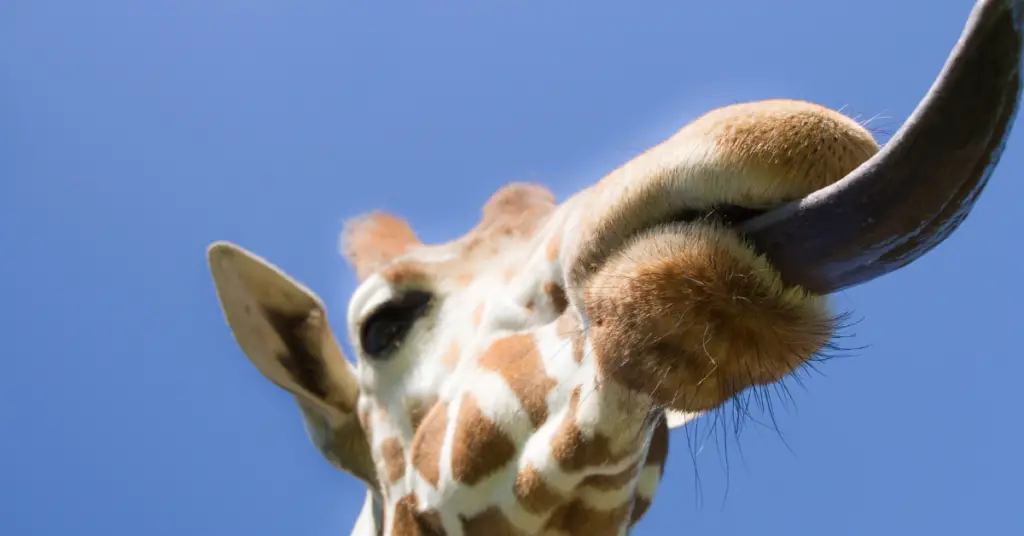Did you know that there is a fascinating world of animals with long tongues that you may not be aware of?
From the graceful Giraffe to the elusive Tube-lipped Nectar Bat, these creatures have evolved remarkable adaptations to suit their specialized needs.
In this article, we will take a closer look at the incredible diversity of animals with long tongues and explore the various purposes they serve.
Whether it’s for feeding, drinking, grooming, or communication, these animals have developed extraordinary tongue structures that allow them to thrive in their environments.
Prepare to be amazed by the ingenuity of nature and the astonishing range of animals with extraordinary tongues.
Giant Pangolin
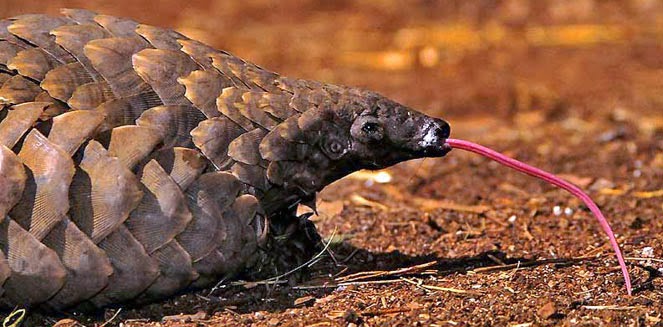
If you come across a Giant Pangolin in the wild, you might be surprised by its incredibly long tongue. The giant pangolin, scientifically known as Manis gigantea, is a fascinating mammal found in the forests and grasslands of Central and West Africa. It’s the largest species of pangolin, measuring up to 5 feet in length and weighing up to 70 pounds.
The giant pangolin’s tongue is a remarkable adaptation for its diet, which consists mainly of ants and termites. The tongue of the giant pangolin can extend up to 16 inches in length, allowing it to reach deep into ant hills and termite mounds to extract its prey. This tongue is covered in a sticky saliva that helps the pangolin capture and hold onto the insects. In fact, the giant pangolin’s tongue is so long that it rivals that of the tube-lipped nectar bat, another animal known for its long tongue.
The giant pangolin’s tongue isn’t only long, but also extremely flexible and muscular. It can be rapidly extended and retracted, enabling the pangolin to quickly and efficiently capture its food. Additionally, the tongue is coated with tiny backward-facing spines, which aid in scooping up insects and preventing them from escaping.
Giraffe
The next animal with a long tongue is the giraffe, known for its incredible height and unique feeding habits. Here are three fascinating aspects of the giraffe’s biology:
- Giraffe’s Neck Adaptation: The giraffe’s long neck is a remarkable adaptation that allows it to reach vegetation in tall trees. Contrary to popular belief, the giraffe’s neck doesn’t contain more vertebrae than other mammals; instead, each vertebra is elongated, providing the necessary length. Additionally, the giraffe has specialized blood vessels and a complex network of valves in its neck to regulate blood flow and prevent excessive pressure when bending down to drink or eat. These adaptations enable the giraffe to reach leaves that are out of reach for other herbivores.
- Giraffe’s Feeding Behavior: The giraffe is a herbivorous animal, primarily feeding on leaves and buds of trees and shrubs. To access the foliage, the giraffe uses its long, muscular tongue, which can extend up to 18 inches. The tongue is prehensile, meaning it can wrap around branches and strip them of their leaves. The giraffe’s tongue is also tough and covered in a thick layer of saliva, allowing it to protect against thorny or spiky vegetation. This unique feeding behavior allows the giraffe to meet its nutritional needs in its arid savannah habitat.
- Giraffe’s Digestive System: In addition to its long tongue, the giraffe has a specialized digestive system to process the tough plant material it consumes. The giraffe’s stomach is divided into four compartments, including the rumen and the omasum, which aid in the breakdown of cellulose and extraction of nutrients from plant matter. This digestive system allows the giraffe to efficiently extract nutrients from its diet and survive in its challenging environment.
The giraffe’s neck adaptation and feeding behavior are remarkable examples of how an animal’s anatomy and behavior can evolve to exploit specific ecological niches. Understanding these adaptations helps shed light on the fascinating world of animal biology.
Okapi
Moving on to the next animal with a long tongue, let’s talk about the okapi. The okapi (Okapia johnstoni) is a unique mammal native to the dense rainforests of Central Africa, specifically the Democratic Republic of Congo. They inhabit the Ituri Forest, where they find shelter in the understory vegetation, utilizing their long tongues to reach for leaves, fruits, and other plant materials.
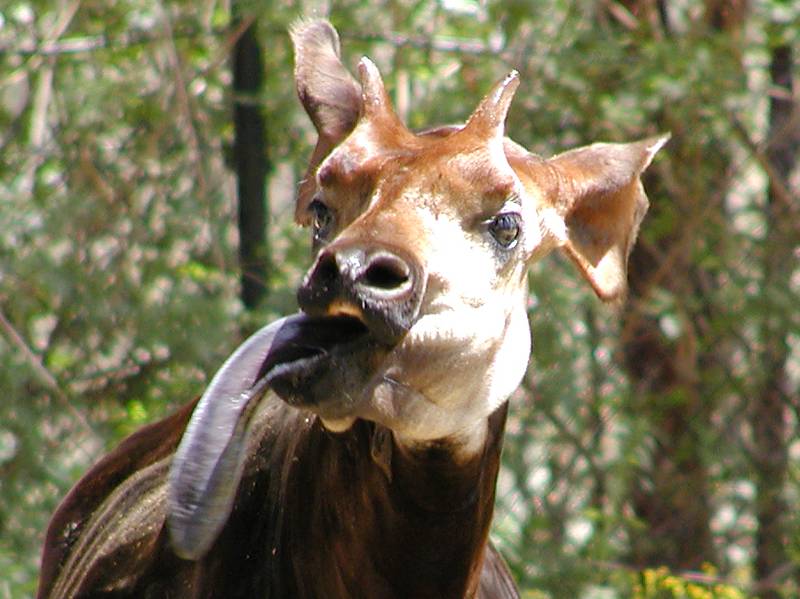
The okapi is classified as Endangered on the IUCN Red List of Threatened Species. The major threats to their survival include habitat loss due to deforestation, illegal hunting for bushmeat, and civil unrest in the region. Efforts are being made to conserve the okapi’s habitat and protect them from poaching. The Okapi Wildlife Reserve, established in 1992, covers approximately 13,700 square kilometers and serves as a sanctuary for the species.
Conservation organizations, such as the Okapi Conservation Project, work tirelessly to raise awareness about the okapi’s conservation status and implement measures to safeguard their population. These include anti-poaching patrols, education programs, and sustainable community development project
Green Woodpecker
The Green Woodpecker (Picus viridis) is known for its unique tongue anatomy, which plays a crucial role in its feeding habits and behavior.
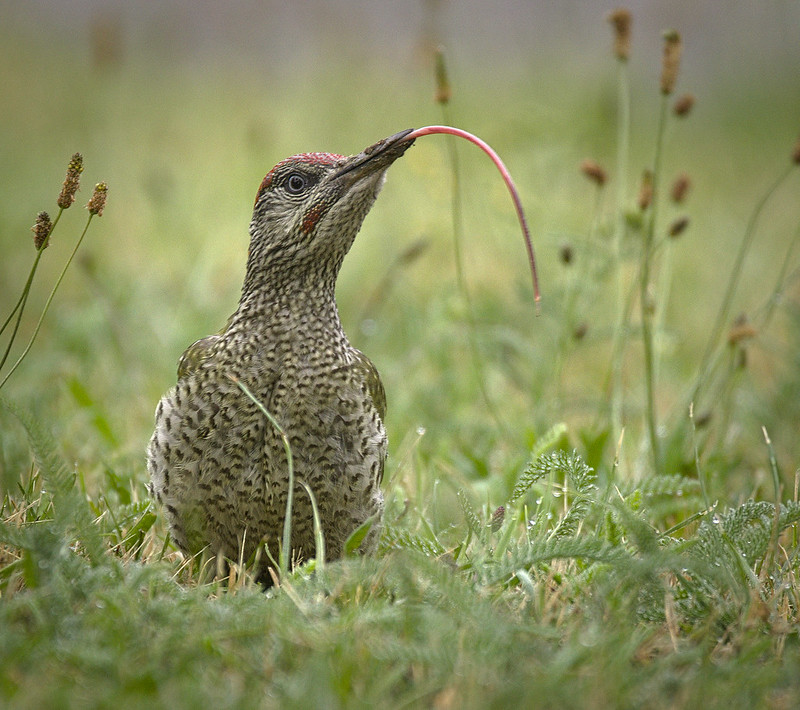
The tongue of the Green Woodpecker is exceptionally long, measuring up to 10 centimeters in length. This specialized tongue enables the woodpecker to extract insects from crevices in trees, allowing it to access hidden food sources that other birds can’t reach.
Woodpecker Tongue Anatomy
The remarkable anatomy of the woodpecker tongue enables it to extract insects from tree bark with extraordinary efficiency. The woodpecker tongue has several adaptations that contribute to its unique function.

- The woodpecker tongue is long and flexible, allowing it to reach deep into crevices in tree bark where insects hide. This length is achieved by extending from the base of the woodpecker’s beak all the way to the back of its skull.
- The tongue is covered in barbs or bristles that point backwards. These barbs help to trap insects and prevent them from escaping as the woodpecker withdraws its tongue from the bark.
- The tip of the woodpecker tongue is sticky, thanks to a gland that secretes a sticky saliva. This stickiness further aids in capturing and holding onto insects.
Role of Tongue in Woodpecker Behavior
As we delve into the fascinating role of the tongue in woodpecker behavior, let’s explore how the Green Woodpecker’s tongue enables it to efficiently extract ants from tree trunks.
The woodpecker tongue is a remarkable adaptation that aids in its feeding techniques. Here are three key features of the woodpecker tongue:
- Length and Flexibility: The Green Woodpecker’s tongue is long, measuring up to 10 centimeters, allowing it to reach deep into tree crevices. The tongue is also highly flexible, enabling it to maneuver around obstacles and extract ants from their nests.
- Barbed Tip: At the end of the tongue, the Green Woodpecker possesses a barbed tip. This structure helps in capturing and securing the ants, ensuring they don’t escape during extraction.
- Sticky Saliva: The woodpecker’s saliva is viscous and sticky, acting as a natural adhesive. This sticky saliva helps in trapping the ants on the barbed tip of the tongue, facilitating their removal from the tree trunk.
The woodpecker tongue adaptations, including its length, flexibility, barbed tip, and sticky saliva, play a crucial role in the Green Woodpecker’s efficient feeding technique of extracting ants from tree trunks.
Sun Bear
The tongue of the Sun Bear (Helarctos malayanus) is a remarkable organ, designed specifically for its feeding habits. With a long and flexible structure, the Sun Bear’s tongue plays a crucial role in extracting insects, honey, and fruits from tight spaces. Its unique adaptations, such as a rough texture and the ability to extend up to 25 centimeters, enable efficient foraging and feeding.
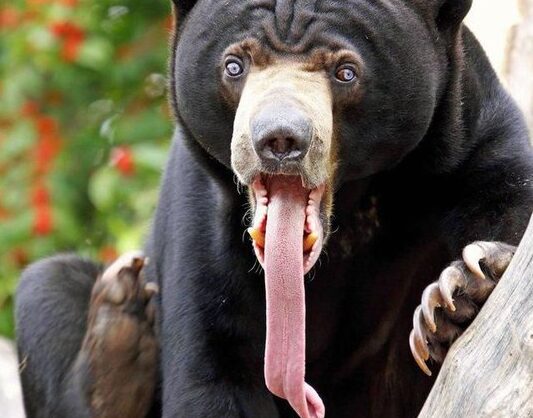
Sun Bear’s Tongue Structure
One interesting aspect of the Sun Bear’s tongue structure is its unique length and flexibility. This adaptation allows the Sun Bear to access hard-to-reach food sources, such as insects and honey.
Here are three key features of the Sun Bear’s tongue structure:
- Long and slender: The Sun Bear’s tongue can extend up to 25 centimeters in length, enabling it to reach deep into crevices to extract food. This elongated tongue aids in the bear’s foraging abilities.
- Papillae and taste buds: The Sun Bear’s tongue is covered with numerous small, backward-facing papillae that enhance its sense of taste. These papillae are densely packed with taste buds, allowing the bear to discern various flavors and textures.
- Sticky saliva: The Sun Bear’s tongue produces a sticky saliva that aids in capturing and holding onto prey, particularly insects. This adhesive saliva helps the bear secure its food before consuming it.
Tube-lipped Nectar Bat
Tube-lipped Nectar Bats have a unique adaptation that allows them to effectively extract nectar from flowers. These bats are found in the cloud forests of Ecuador, Colombia, and Costa Rica. They’ve a specialized tongue that’s remarkably long, measuring up to three times the length of their body. This long tongue is perfectly suited for their nectar feeding adaptations.
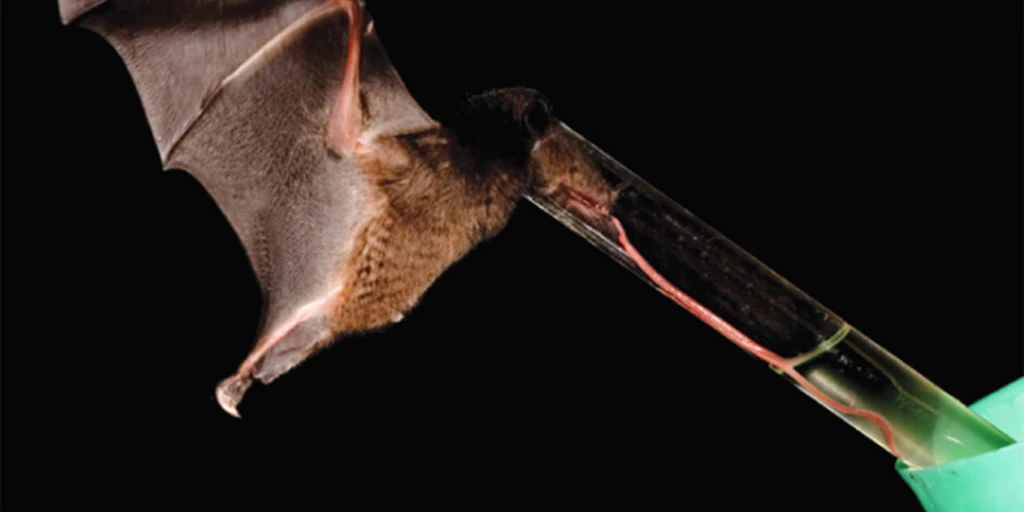
The tube-lipped nectar bat’s tongue is thin and flexible, allowing it to be inserted deep into the flowers. The tip of the tongue is equipped with tiny bristles, which help to collect and hold the nectar. As the bat extends its tongue into a flower, it unfurls, creating a tube-like structure that acts as a straw. This enables the bat to efficiently suck up the nectar.
Not only do the tube-lipped nectar bats benefit from their long tongues, but they also play a crucial role in the pollination process. As they feed on nectar, their tongues become coated with pollen grains. When they move on to the next flower, some of this pollen rubs off onto the flower’s reproductive structures, facilitating cross-pollination. In this way, these bats act as important pollinators for a variety of plant species.
The unique adaptation of the tube-lipped nectar bat’s long tongue allows them to have a specialized feeding strategy and contribute to the ecological balance of their habitat.
Chameleons
Chameleons, with their remarkable ability to change color, further demonstrate the diversity of animals with long tongues. These fascinating creatures possess unique adaptations in their tongues that enable them to capture prey with precision and efficiency.
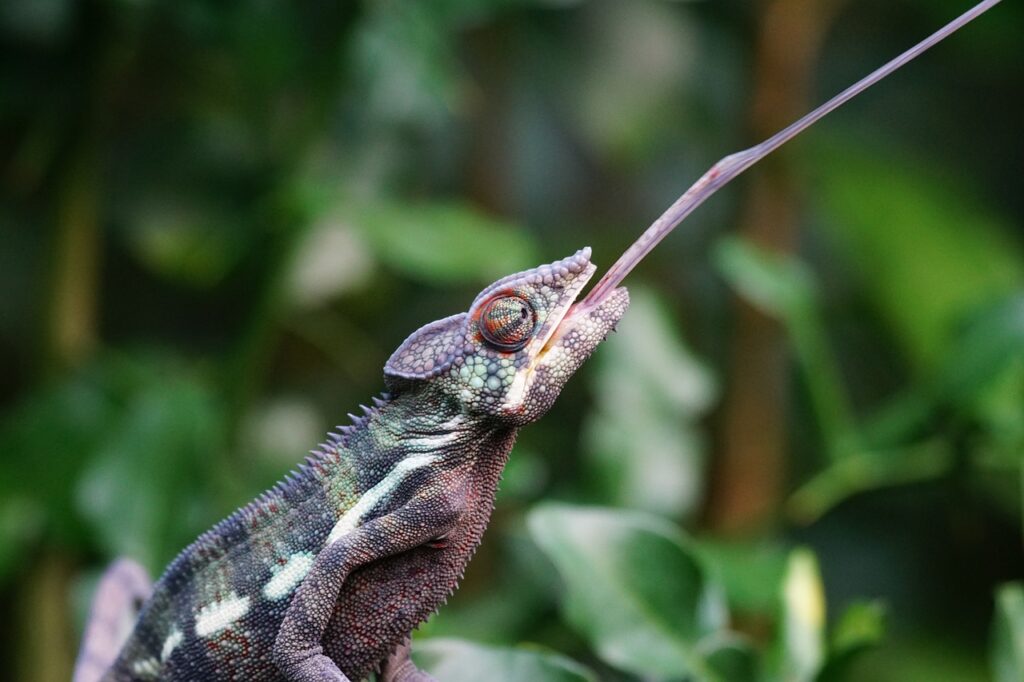
- Tongue Structure: The tongue of a chameleon is long, slender, and highly flexible. It’s attached to the front of the mouth and can be extended to a length twice the body size. This allows chameleons to reach insects that are out of their immediate reach.
- Projectile Tongue: Chameleons have a specialized tongue mechanism known as a ‘ballistic’ tongue. When hunting, they rapidly extend their tongue towards their prey, shooting it out at a high speed. The tongue has a sticky tip that adheres to the prey, allowing the chameleon to quickly retract it back into their mouth.
- Prey Capture: Chameleons primarily feed on insects such as crickets, grasshoppers, and flies. Their tongue adaptations, combined with their exceptional eyesight, enable them to accurately target and capture their prey from a distance. This method of hunting is highly efficient and ensures a successful meal for the chameleon.
Understanding chameleon tongue adaptations provides insight into the diversity of feeding behaviors among animals with long tongues. It’s fascinating to compare these adaptations with other creatures, such as the tube-lipped nectar bat, which uses its elongated tongue to extract nectar from flowers. The variety of tongue structures and functions in the animal kingdom is a testament to the remarkable adaptability and evolution of these remarkable organisms.
Comparison of Animal Tongue Sizes
| Animal | Tongue Length (in) | Tongue Length (cm) |
|---|---|---|
| Giant Pangolin | 10-12 | 25-30 |
| Okapi | 12-14 | 30-35 |
| Giraffe | 18-20 | 45-50 |
| Green Woodpecker | 4-5 | 10-13 |
| Sun Bear | 8-10 | 20-25 |
| Chameleon | 1.5-2 times body length | 30-60 (depending on species) |
| Tube-lipped Nectar Bat | 3-4 | 7-10 |
| Anteater | 2-3 | 5-7.5 |
| Aye-Aye | 6-8 | 15-20 |
| Giraffe-necked Weevil | 1-2 | 2.5-5 |
| Elephant | 18-21 | 45-53 |
| Cow | 12-18 | 30-45 |
| Ox | 12-18 | 30-45 |

Erzsebet Frey (Eli Frey) is an ecologist and online entrepreneur with a Master of Science in Ecology from the University of Belgrade. Originally from Serbia, she has lived in Sri Lanka since 2017. Eli has worked internationally in countries like Oman, Brazil, Germany, and Sri Lanka. In 2018, she expanded into SEO and blogging, completing courses from UC Davis and Edinburgh. Eli has founded multiple websites focused on biology, ecology, environmental science, sustainable and simple living, and outdoor activities. She enjoys creating nature and simple living videos on YouTube and participates in speleology, diving, and hiking.
🌿 Explore the Wild Side!
Discover eBooks, guides, templates and stylish wildlife-themed T-shirts, notebooks, scrunchies, bandanas, and tote bags. Perfect for nature lovers and wildlife enthusiasts!
Visit My Shop →
